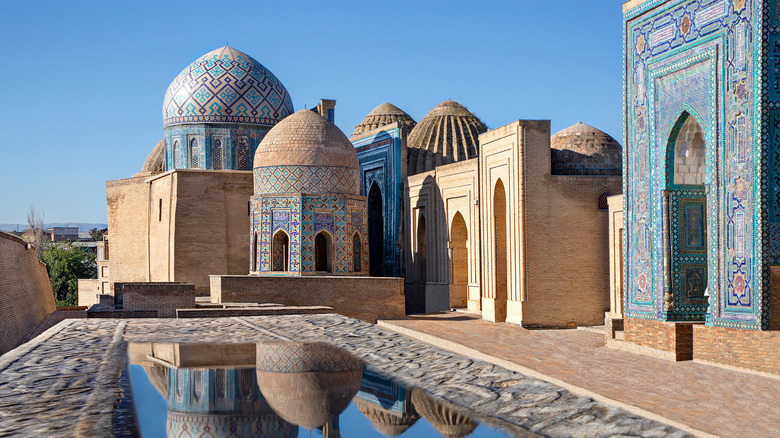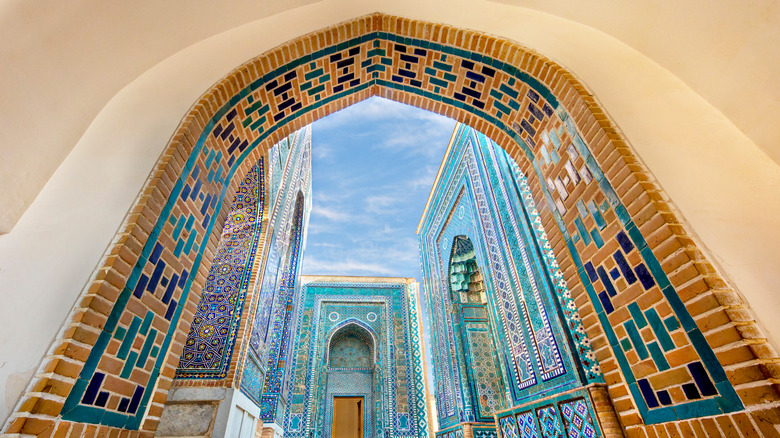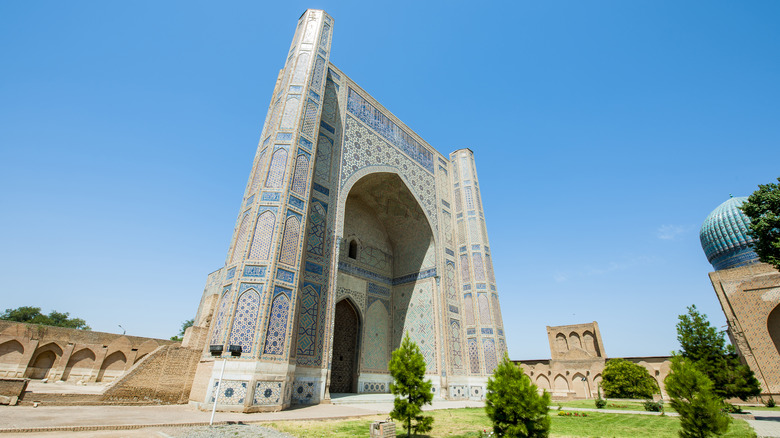This City In Asia Is A Great Addition To Any History Buff's Bucket List
History buffs from the West often find themselves vacationing in places like England, Spain, Italy, or Egypt. There is so much history and historical architecture and culture to take in. Of course, there are many, many people with the same idea, leading to long lines and tourist traps. Sometimes it's wonderful to go off the beaten path, away from where everyone ventures. We've got a suggestion for a wonderful city for history buffs. That city is Samarkand in Uzbekistan in Central Asia. The country sits between the rivers Syr Darya and Amu Darya, with Samarkand as one of its shining jewels. Samarkand is one of the oldest continuously inhabited cities in the world and was once captured by Alexander the Great in 329 BCE. In fact, the city was founded in 700 BCE. Genghis Khan destroyed the city in 1220 CE, and in 1365, it became part of the Timur empire.
This city has stunning architecture, from the lovely mosques to the observatory of Ulūgh Beg, a 15th-century astronomer, to the impressive madrasahs or Islamic learning centers. It was declared a UNESCO World Heritage Site in 2001. Let's take a look at Samarkand, what history buffs can see, and what to do in the area.
What to see in Samarkand
The city was a stop on the nearly 4,000-mile-long Eurasian Silk Road trade route, which was active from around the second century through the mid-15th century. Samarkand is full of medieval architecture, largely commissioned by ruler Amir Timur in 1370. One such marvel is Registan Square. There are three incredibly beautiful madrasahs there; Ulūgh Beg, built during the early 15th century, Sher-Dor, from the early 17th century, and Tilya-Kori from the mid-17th century. The colorful tilework is breathtaking to behold. Their bottom floor houses vendors, where you can get lovely souvenirs. During the spring and summer, you can watch traditional musical performances in the evening. You can even climb one of the minarets for a lovely view. Do note that the stairs up are very small and are a little precarious.
You should also make a point to visit the Shahi Zinda necropolis. Much of the tilework here is from the 14th century, though some of it has been replaced during recent renovations, still, the turquoise walls will blow your mind. The area was added to over the years between the 11th century and the 19th century, and there is a legend that says that Muhammad's cousin Qusam ibn-Abbas is buried here. You must conform to modest dress to enter, covering your shoulders and knees, much like you would in churches in Italy. If tilework is your thing, you cannot miss the Gur-e-Amir, the mausoleum housing the remains of Amir Timur and Ulūgh Beg. Again, modest dress applies.
What to do in Samarkand
If you love ruins, visit Afrasiyab, a very old part of Samarkand ruled by the Zoroastrian Sogdians from 500 BCE to 1220 CE. The remains of their buildings are explorable, though you should note that the ground is uneven. Bring the right shoes, as Samarkand is a great walking city, even outside of this area. There is also an Afrasiyab museum next door. Another place that is lovely is the 1404 CE Bibi-Khanym Mosque, which is one of the largest in this part of the world.
The Ulūgh Beg Observatory was built in the early 15th century and was well-known by the scientists of the day. It tracked the movement of the sun and was incredibly accurate. It's only about a minute off all these centuries later. It was destroyed after Ulugh Beg's death but rediscovered in the early 20th century. It's now a museum with a model of the original and a statue of Ulūgh Beg.
Finally, no trip to Samarkand is complete without sampling the local cuisine, like plov, which is a rice dish with ingredients like beef or mutton, onions, and raisins, though it varies from place to place. You can find obi non bread, cooked in a clay oven with decoration and stamping, achichuk, a tomato and onion salad, and samsa, much like a samosa with meat filling. According to Food and Travel, Russian influence in Samarkand lends itself to plenty of culinary delights from that region too.


